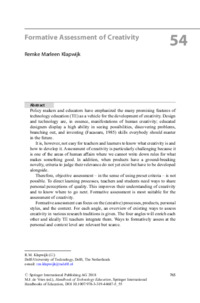Formative Assessment of CreativityRemke Marleen Klapwijk
|
 |
 Diese Seite wurde seit 7 Jahren inhaltlich nicht mehr aktualisiert.
Unter Umständen ist sie nicht mehr aktuell.
Diese Seite wurde seit 7 Jahren inhaltlich nicht mehr aktualisiert.
Unter Umständen ist sie nicht mehr aktuell.
 Zusammenfassungen
Zusammenfassungen
 Policy makers and educators have emphasized the many promising features of technology education (TE) as a vehicle for the development of creativity. Design and technology are, in essence, manifestations of human creativity; educated designers display a high ability in seeing possibilities, discovering problems, branching out, and inventing (Facaoaru, 1985) skills everybody should master in the future.
Policy makers and educators have emphasized the many promising features of technology education (TE) as a vehicle for the development of creativity. Design and technology are, in essence, manifestations of human creativity; educated designers display a high ability in seeing possibilities, discovering problems, branching out, and inventing (Facaoaru, 1985) skills everybody should master in the future.It is, however, not easy for teachers and learners to know what creativity is and how to develop it. Assessment of creativity is particularly challenging because it is one of the areas of human affairs where we cannot write down rules for what makes something good. In addition, when products have a ground-breaking novelty, criteria to judge their relevance do not yet exist but have to be developed alongside.
Therefore, objective assessment - in the sense of using preset criteria - is not possible. To direct learning processes, teachers and students need ways to share personal perceptions of quality. This improves their understanding of creativity and to know where to go next. Formative assessment is most suitable for the assessment of creativity.
Formative assessment can focus on the (creative) processes, products, personal styles, and the context. For each angle, an overview of existing ways to assess creativity in various research traditions is given. The four angles will enrich each other and ideally TE teachers integrate them. Ways to formatively assess at the personal and context level are relevant but scarce.
 Dieses Kapitel erwähnt ...
Dieses Kapitel erwähnt ...
 Personen KB IB clear | Edward de Bono , Mihaly Csikszentmihalyi , Michael Polanyi , Sir Ken Robinson | |||||||||||||||||||||||||||||||||||||||||||||
 Begriffe KB IB clear | Bildungeducation (Bildung)
, Gymnasium
, Informatikcomputer science
, Informatik-Unterricht (Fachinformatik)Computer Science Education
,  Kreativität Kreativität creativity
, creativity
,  LehrerIn LehrerIn teacher
, teacher
,  Schule Schule school
, school
,  Schweiz Schweiz Switzerland
, Switzerland
,  Sekundarstufe II Sekundarstufe II
| |||||||||||||||||||||||||||||||||||||||||||||
 Bücher |
|
 Dieses Kapitel erwähnt vermutlich nicht ...
Dieses Kapitel erwähnt vermutlich nicht ... 
 Nicht erwähnte Begriffe | Digitalisierung, Eltern, Informatik-Didaktik, Informatikunterricht in der Schule, Kinder, Lehrplan 21, Lernen, Unterricht |
 Tagcloud
Tagcloud
 Zitationsgraph
Zitationsgraph
 Zitationsgraph (Beta-Test mit vis.js)
Zitationsgraph (Beta-Test mit vis.js)
 1 Erwähnungen
1 Erwähnungen 
 Anderswo finden
Anderswo finden
 Volltext dieses Dokuments
Volltext dieses Dokuments
 |  Formative Assessment of Creativity: Artikel als Volltext bei Springerlink ( Formative Assessment of Creativity: Artikel als Volltext bei Springerlink ( : :  , 406 kByte; , 406 kByte;  : :  ) ) |
 Anderswo suchen
Anderswo suchen 
 Beat und dieses Kapitel
Beat und dieses Kapitel
Beat hat Dieses Kapitel während seiner Zeit am Institut für Medien und Schule (IMS) ins Biblionetz aufgenommen. Beat besitzt kein physisches, aber ein digitales Exemplar. Eine digitale Version ist auf dem Internet verfügbar (s.o.). Es gibt bisher nur wenige Objekte im Biblionetz, die dieses Werk zitieren.












 Biblionetz-History
Biblionetz-History